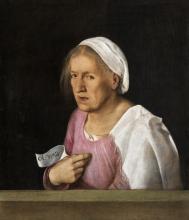From the Vendramin collection, where it was held until at least 1601 along with others of Giorgione’s autograph paintings such as The Tempest, the work was bought by the merchant Cristoforo Orsetti, who mentions it in his will in 1664, by which it was bequeathed to his son Giovanni Battista, who added it to his own collection. It was only later, at an unspecified date, that the work was added to the Manfrin collections from which it was bought by the Italian state in 1846 along with other important works.
A fundamental painting in Giorgione’s very small catalogue, the work continues to surprise viewers because of the absolutely unique nature of its subject – an old woman depicted with extreme realism, her face ravaged by time and showing deep wrinkles, her teeth either crooked or missing. From the 1601 Vendramin inventory we can infer that The Old Woman was stored with a “cover” (or a painting that served as such) depicting a male portrait, whose combined reading might help in understanding the painting’s hidden meaning, which is perhaps even more complex than a simple meditation on the theme of vanitas. Compared with the contemporary artistic scene in Venice, there is no doubt that Giorgione’s choice to deal with a similar theme so directly was revolutionary, and was certainly inspired on the one hand by his study of Leonardo (note the similarity between the Old Woman and Philip the apostle in the Last Supper at Santa Maria delle Grazie), and on the other by Nordic prototypes (for example, Dürer’s Portrait of a Young Man in Vienna, the back of which had a picture of an old woman with a bag of coins). It is plausible that the subject held a specific meaning for the client, who was probably Gabriele Vendramin himself considering his family’s coat of arms is on the old frame, and that the cartouche cotaining the words “col tempo” (with time), most likely the opening words of a citation or a message, might be an allusion to this meaning.

